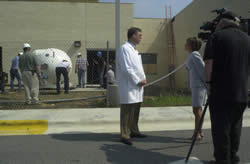Medical center receives new tool for brain tumors
Equipped with a crane, jacks and dollies, crews on July 19 installed the 20-ton heart of what will be a new tool in the Leo W. Jenkins Cancer Center’s fight against benign and malignant brain tumors and selected other disorders.
The device is the Leksell Gamma Knife, though it’s not actually a knife. It uses gamma rays to allow radiation oncologists and neurosurgeons to treat brain tumors, lesions, blood vessel malformations and other problems of the brain without making an incision. The Gamma Knife uses a single dose of radiation, directed simultaneously through 201 ports in a special device patients wear on their heads, to specific targets within the brain. The beams intersect at the tumor or other target and destroy abnormal tissue while leaving normal tissue intact.

Dr. Marcus Randall is interviewed by WNCT Channel 9 reporter Laura Barron as a crew rolls the Leo W. Jenkins Cancer Center’s Gamma Knife radiation unit into its new home on the medical campus. Photo by Doug Boyd
Dr. Marcus Randall, director of the Leo W. Jenkins Cancer Center and professor of radiation oncology at the Brody School of Medicine at East Carolina University, will serve as radiation oncology co-director of the Gamma Knife program. Dr. Barbara Lazio of Eastern Neurosurgical and Spine Associates will serve as surgical co-director. Both have previous experience working with the devices.
“It gives us the capability to treat some patients that in the past we couldn’t treat here,” Randall said. “And for some patients we might have treated before, it gives us a better way to treat them.”
Several patients have already been identified as candidates for treatment with the device, which should go into service in October.
State officials last year approved a plan by Pitt County Memorial Hospital to buy and install the device, only the second one in the state. The other is at Wake Forest University in Winston-Salem. PCMH has built a 2,800-square-foot addition to the magnetic resonance imaging facility on the property of the medical school to house the Gamma Knife. PCMH is leasing the land and facility from ECU.
Total cost is estimated to be nearly $5.6 million, with about $3.7 million of that going for the gamma knife itself. PCMH is footing the bill.
Physicians must be trained and credentialed to use the Gamma Knife. The third member of the team that will conduct procedures, along with the neurosurgeon and radiation oncologist, will be an ECU radiation physicist, who is also trained and credentialed.
“Currently all ECU (radiation oncologists) are treating with stereotactic radiosurgery, and the Gamma Knife is an extension of this technique,” said Dr. Ron Allison, chairman of the Department of Radiation Oncology. “So in reality we are able to go directly into Gamma Knife radiosurgery without much trouble as we have been offering this service for (three) years.”
The device is made by Elekta AB of Sweden. Gamma Knife surgery is generally an outpatient procedure with patients staying fewer than 24 hours in the hospital. Patients are usually able to resume normal activities within 48 hours. The total procedure itself, which also requires patients to undergo a magnetic resonance imaging test, generally takes two to three hours, according to Randall.
Traditional brain surgery, on the other hand, requires about a week in the hospital and six to eight weeks of recovery.
“This certainly won’t replace brain surgery,” Randall said. “In some cases, that’s still a better treatment.”
The Gamma Knife has no moving parts during treatment, which improves safety, accuracy, reliability and reproducibility. Because of its accuracy, the device allows doctors to treat tumors previously thought inoperable, including tumors near the brainstem, cranial nerves and optic apparatus. Radiation comes from 201 individual cobalt-60 radioactive sources installed in the device.